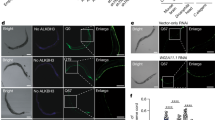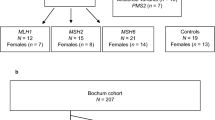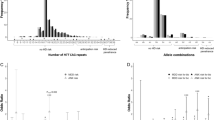Abstract
Machado–Joseph disease (MJD) is an autosomal dominant neurodegenerative disorder of late onset (occurring at a mean age of 40.2 years). The clinical manifestation of MJD is dependent on the presence of an expansion of the (CAG)n motif within exon 10 of the ATXN3 gene, located at 14q32.1. The variance in onset of MJD is only partially correlated (∼50–80%) with the extension of the CAG tract in genomic DNA (gDNA). The main aim of this work was to determine whether there are discrepancies in the size of the (CAG)n tract between gDNA and mRNA, and to establish whether there is a better association between age at onset and repeat size at the mRNA level. We typed gDNA and cDNA samples for the (CAG)n tract totalizing 108 wild-type and 52 expanded ATXN3 alleles. In wild-type alleles no differences were found between gDNA and cDNA. In expanded alleles, the CAG repeat size in gDNA was not always directly transcribed into the mRNA; on average there were differences of +1 repeat at the cDNA level. The slight discrepancies obtained were insufficient to cause significant differences in the distribution of the expanded alleles, and therefore no improvement in onset variance explanation was obtained with mRNA.
Similar content being viewed by others
Log in or create a free account to read this content
Gain free access to this article, as well as selected content from this journal and more on nature.com
or
References
Schols L, Bauer P, Schmidt T, Schulte T, Riess O : Autosomal dominant cerebellar ataxias: clinical features, genetics, and pathogenesis. Lancet Neurol 2004; 3: 291–304.
Bettencourt C, Santos C, Kay T, Vasconcelos J, Lima M : Analysis of segregation patterns in Machado-Joseph disease pedigrees. J Hum Genet 2008; 53: 920–923.
Coutinho P, Andrade C : Autosomal dominant system degeneration in Portuguese families of the Azores Islands. A new genetic disorder involving cerebellar, pyramidal, extrapyramidal and spinal cord motor functions. Neurology 1978; 28: 703–709.
Kawaguchi Y, Okamoto T, Taniwaki M et al: CAG expansions in a novel gene for Machado-Joseph disease at chromosome 14q32.1. Nat Genet 1994; 8: 221–228.
Ichikawa Y, Goto J, Hattori M et al: The genomic structure and expression of MJD, the Machado-Joseph disease gene. J Hum Genet 2001; 46: 413–422.
Maciel P, Costa MC, Ferro A et al: Improvement in the molecular diagnosis of Machado-Joseph disease. Arch Neurol 2001; 58: 1821–1827.
van Alfen N, Sinke RJ, Zwarts MJ et al: Intermediate CAG repeat lengths (53,54) for MJD/SCA3 are associated with an abnormal phenotype. Ann Neurol 2001; 49: 805–807.
Maciel P, Gaspar C, DeStefano AL et al: Correlation between CAG repeat length and clinical features in Machado-Joseph disease. Am J Hum Genet 1995; 57: 54–61.
Maruyama H, Nakamura S, Matsuyama Z et al: Molecular features of the CAG repeats and clinical manifestation of Machado-Joseph disease. Hum Mol Genet 1995; 4: 807–812.
Lopes-Cendes I, Maciel P, Kish S et al: Somatic mosaicism in the central nervous system in spinocerebellar ataxia type 1 and Machado-Joseph disease. Ann Neurol 1996; 40: 199–206.
Fabre E, Dujon B, Richard G-F : Transcript and nuclear transport of CAG/CTG trinucleotide repeats in yeast. Nucleic Acids Res 2002; 30: 3540–3547.
Bettencourt C, Fialho RN, Santos C et al: Segregation distortion of wild-type alleles at the Machado-Joseph disease locus: a study in normal families from the Azores islands (Portugal). J Hum Genet 2008; 53: 333–339.
SPSS Inc.: SPSS for Windows: Release 15. Chicago: SPSS Inc., 2006.
Raymond M, Rousset F : GENEPOP (version 1.2): population genetics software for exact tests and ecumenicism. J Heredity 1995; 86: 248–249.
Sinden RR, Potaman VN, Oussatcheva EA, Pearson CE, Lyubchenko YL, Shlyakhtenko LS : Triplet repeat DNA structures and human genetic disease: dynamic mutations from dynamic DNA. J Biosci 2002; 27 (Suppl 1): 53–65.
Ito Y, Tanaka F, Yamamoto M et al: Somatic mosaicism of the expanded CAG trinucleotide repeat in mRNAs for the responsible gene of Machado-Joseph disease (MJD), dentatorubral-pallidoluysian atrophy (DRPLA), and spinal and bulbar muscular atrophy (SBMA). Neurochem Res 1998; 23: 25–32.
Acknowledgements
This work was supported by projects ‘PRI-DMJ’ (funded by the Regional Government of the Azores) and ‘Transcriptional variation of the ATXN3 gene as modulator of the clinical heterogeneity in Machado–Joseph disease (MJD)’ (PIC/IC/83074/2007, funded by ‘Fundação para a Ciência e a Tecnologia’ – FCT). CB (SFRH/BD/21875/2005) is the recipient of a PhD grant from FCT.
Author information
Authors and Affiliations
Corresponding author
Ethics declarations
Competing interests
The authors declare no conflict of interest.
Rights and permissions
About this article
Cite this article
Bettencourt, C., Santos, C., Montiel, R. et al. The (CAG)n tract of Machado–Joseph Disease gene (ATXN3): a comparison between DNA and mRNA in patients and controls. Eur J Hum Genet 18, 621–623 (2010). https://doi.org/10.1038/ejhg.2009.215
Received:
Revised:
Accepted:
Published:
Issue date:
DOI: https://doi.org/10.1038/ejhg.2009.215
Keywords
This article is cited by
-
Sodium valproate increases activity of the sirtuin pathway resulting in beneficial effects for spinocerebellar ataxia-3 in vivo
Molecular Brain (2021)
-
Transcript Diversity of Machado–Joseph Disease Gene (ATXN3) Is Not Directly Determined by SNPs in Exonic or Flanking Intronic Regions
Journal of Molecular Neuroscience (2013)
-
Sequence Analysis of 5′ Regulatory Regions of the Machado–Joseph Disease Gene (ATXN3)
The Cerebellum (2012)
-
Parkinsonian phenotype in Machado-Joseph disease (MJD/SCA3): a two-case report
BMC Neurology (2011)
-
Evaluation of CAG repeat length of androgen receptor expressing cells in human testes showing different pictures of spermatogenic impairment
Histochemistry and Cell Biology (2011)



